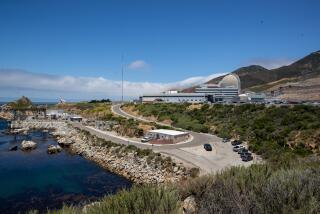New Research to Spare Simi Lab From Closure : Science: The Department of Energy, which had planned to shut down the site, will study a new technology for electrical generation.
- Share via
The Department of Energy announced Thursday that it will keep open its Energy Technology Engineering Center near Simi Valley to do research on a promising new technology for electrical power generation, known as the Kalina Cycle.
The center had been scheduled for closure in September, with a loss of 200 high-tech jobs. It is operated by the Rocketdyne division of Rockwell International, which for decades tested components for nuclear power plants at the site.
“The issue in my mind was that we cannot lose this resource,” Energy Secretary Hazel O’Leary said Thursday at a news conference in Los Angeles.
The center, part of the Department of Energy’s Santa Susana Field Laboratory, is now assured funding through 1995 and will get a budget hike of $11.6 million, most of it to test the new technology, a prototype of which is already in place.
Community groups and proponents of an advanced transportation industry in Southern California have been lobbying hard to keep the site open. In December, DOE successfully sought out industrial partners to help support the center’s continued operation.
“The future of ETEC really gives us something positive to look forward to,” said Bonny Matheson, president of Valley Industry and Commerce Assn., which represents more than 350 businesses in Ventura and Los Angeles counties. Matheson also spoke at Thursday’s news conference.
The energy technology center’s mission to develop cleaner and more efficient energy systems could also help create more jobs and give local businesses a much-needed boost, said Matheson, who met with O’Leary in February to talk about saving the $1-billion lab.
“Businesses have been so battered after years of tragedy and disaster that this is just a wonderful ray of light,” Matheson said.
Rep. Anthony Beilenson (D-Woodland Hills) helped arrange the meeting between O’Leary and business leaders. “We hope we can look back in a couple of years and see that this not only saved jobs but created other jobs,” Beilenson said.
O’Leary said Thursday that future funding will depend on how successful the center is in attracting private businesses interested in working with the facility. Southern California Gas Co. has already expressed interest in working with the center to develop new uses for natural gas, and Caltrans is also interested in using the lab.
“We still think that a focus on transportation technologies is a premiere use of the site, and we will be working to get DOE’s additional support,” said John Slifko, special assistant for technology policy to Rep. Howard L. Berman (D-Panorama City).
But so far, plans focus on development of the new electricity-generation process, Robert LeChevalier, DOE site manager, said Thursday.
“This is a really significant event,” LeChevalier said. “It’s the first new thermodynamic cycle that’s been invented since 1895.”
The new concept was devised by Alexander Kalina, an engineer from the former Soviet Union now living in Northern California. Potentially, it could use almost any heat source--fueled by natural gas, coal or geothermal or solar energy--to produce electricity 20% more efficiently than current turbine technology.
An improvement of this magnitude could mean billions of dollars in energy savings in this country and internationally. The technology center has the world’s sole operating model of the device.
“We’ve demonstrated the principles of the cycle,” LeChevalier said, “and a number of large utility suppliers are very interested . . . one is General Electric.”
The center also has ongoing projects in renewable technologies, energy conservation and earthquake-effects testing. Researchers there can test the effects of seismic events on components used to isolate buildings and bridges from earthquake impacts, or such utility structures as pipe systems in power plants.






